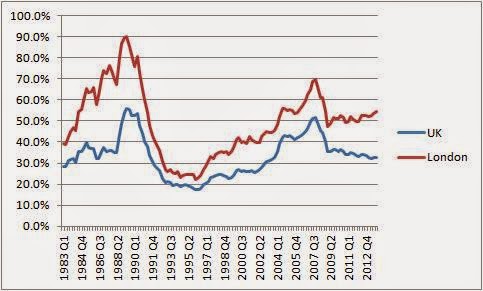Not such a house price bubble?
Here’s an intriguing graph via the economist Simon Wren-Lewis:
Outside London in particular, house prices don’t look so bubble like after all – when you factor in people’s ability to pay for them, which has been hugely increased by the low interest rates we’ve been seeing.
In one respect this shows the brittle nature of our economy – think how damaging a global bout of inflation driving up interest rates would be. But it also shows that current levels of house prices are, in some respects and especially outside London, sustainable and with the pressure continuing to gradually ease (note the downward slope of the blue line over the last few years).
Whether this will really be the case is part of what Simon Wren-Lewis discusses in his excellent blog post; do go take read.

There is a very fundamental oversight in the analysis relating to what inflation and interest rates actually are, how they operate and the effect they have on debt. Mortgage rates were much higher in the 70s than now because inflation was much higher and wage inflation was much higher – a 20% annual pay rise was fairly normal and such pay rises rapidly decreased the proportion of income spent servicing the mortgage which hadn’t increased. A few years of those kind of pay deals and the proportion decreased rapidly. Today, interest rates are low because inflation is low and wage inflation is low. The proportion of income might look low initially but a 1% pay rises make very little difference to the proportion of income servicing the mortgage over the term of the mortgage. You will end up paying less of your gross income over 25 years in a high inflation/high interest rate environment than you will in a low inflation/low interest rate environment.
If you want to look at a much more meaningful metric to determine the affordability of housing then it has to be either the price-to-income ratio, which is historically very high, or the rental yield, which is historically very low. Both these metrics indicate that housing is in a bubble, although away from London things aren’t quite as insane as they were in 2007, but that’s not saying much.